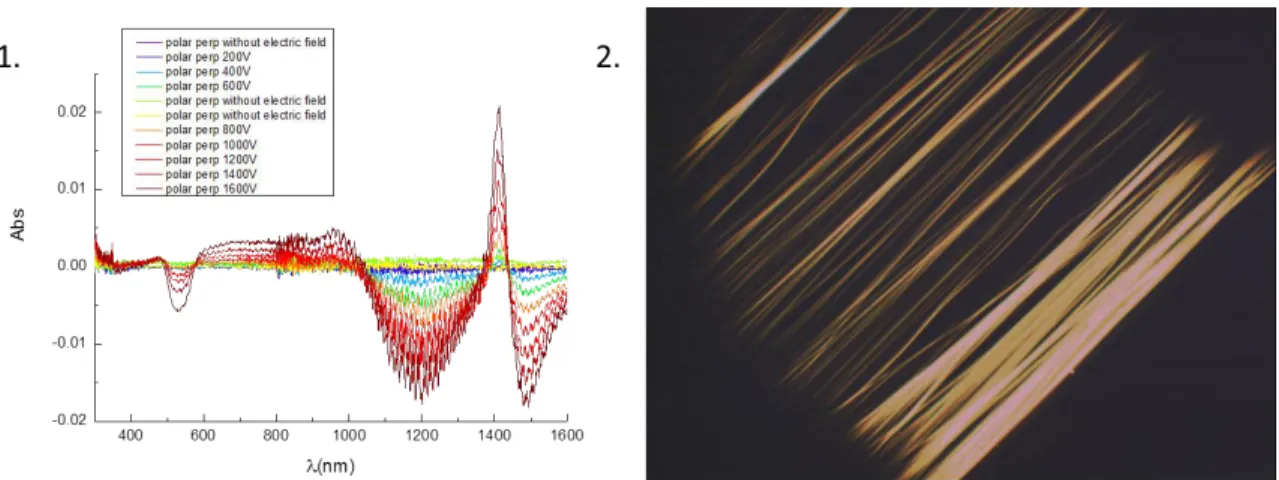HAL Id: hal-01206601
https://hal.archives-ouvertes.fr/hal-01206601
Submitted on 30 Sep 2015
HAL is a multi-disciplinary open access archive for the deposit and dissemination of sci-entific research documents, whether they are pub-lished or not. The documents may come from teaching and research institutions in France or abroad, or from public or private research centers.
L’archive ouverte pluridisciplinaire HAL, est destinée au dépôt et à la diffusion de documents scientifiques de niveau recherche, publiés ou non, émanant des établissements d’enseignement et de recherche français ou étrangers, des laboratoires publics ou privés.
Investigation of electro-optical properties of gold
colloidal suspensions.
Delphine Coursault, Christophe Blanc, Ivan Dozov, Maurizio Nobili, David
Maurin, Jean-Louis Bantignies, Antoine Robert, Lise-Marie Lacroix, G. Viau
To cite this version:
Delphine Coursault, Christophe Blanc, Ivan Dozov, Maurizio Nobili, David Maurin, et al.. Investi-gation of electro-optical properties of gold colloidal suspensions.. Condensed Matter in Paris 2014-CMD25- JMC14, Aug 2014, Paris, France. �hal-01206601�
Investigation of electro-optical properties of gold colloidal suspensions.
D. Coursault1, C. Blanc1, I. Dozov1, M. Nobili1, D. Maurin1, J.L Bantignies1, A. Robert², L-M. Lacroix², G. Viau².
1
Laboratoire Charles Coulomb, UMR 5221 CNRS-UM2,Université Montpellier 2, Place Eugène Bataillon - CC026, F-34095 Montpellier Cedex 5 – France
2
Laboratoire de Physique et Chimie des Nano-Objets, INSA, 135 av. de Rangueil 31077 Toulouse cedex 4- France
Applying an external electric field on a colloidal suspension of anisometric particles can lead to reversible liquid-crystal like ordering. We can expect strong induced birefringence and dichroism depending on dielectric properties of the suspension [1]. In general, colloids are stabilized with ionic surfactants. Colloids alignment along the electric field thus occurs through the reorganization of ions at the particle/solvent interface. In the case of metallic particles, ordering will be achieved through the intrinsic conductivity of the particles. Among the metallic particles, plasmonic ones, like gold nanoparticles, exhibit a transverse localized surface plasmon mode and a longitudinal one, whose resonance red-shift depends on the aspect ratio (AR) of the nanoparticle. The larger the aspect ratio is, the stronger should be their optical anisotropy [2]. It is thus of interest to create reversible ordering of gold nanoparticles as their localized surface plasmon properties make them appealing for applications like bio-sensing or metamaterials.
In this work, we study two kinds of particles: gold nanorods (GNRs) dispersed in water with an aspect ratio AR ≈10 (Φ=10nm) and new ultrathin gold nanowires (GNWs) dispersed in hexane with an AR up to 1000 (Φ=1.5nm) [3].With our recently developed electro-optic setup [1], we measure the birefringence induced in the sample by short pulses of high-frequency electric field. We study also the field-induced dichroism of the suspensions, using the same sample, sealed in a flat optical glass capillary, and the same experimental setup, mounted either on a polarizing microscope or on a UV-Vis spectrophotometer. In our experimental setup, the electrodes are placed outside the sample. In this configuration, they do not interact with the suspension avoiding electrophoretic effect.
We observed alignment of both GNRs and GNWs along the applied electric field. Time responses of GNRs to the electric field are of the order of the millisecond and of more than 10 ms for GNWs. The saturated voltage is 4 times smaller in this last case compared to GNRs. Those results are in agreement with a change in the aspect ratio. In the visible range, birefringence appears negative as theoretically predicted [2]. More surprising, in both cases, a positive linear dichroism is revealed in the optical visible range. On the contrary, we expect a negative dichroism (ie extinction higher for polarization perpendicular to the electric field), while in this frequency range we are sensitive to the transverse mode of the plasmon band [4]. Spectroscopic measurements of the absorbance confirm this result but show in addition that the longitudinal mode is well polarized along the electric field: absorbance increases (decreasing) with the applied electric field for a polarization parallel (perpendicular) to this field. This suggests that the transverse mode is less sensitive to polarization than the longitudinal one (figure 1). This may arise from partial alignment causing light depolarization.
Figure : 1. Absorbance spectra of Gold NanoRods suspension for light polarization perpendicular to the electric field. Reference spectrum has been recorded from the isotropic state. 2. Gold NanoWire fibers oriented at 45° between crossed polarizers.
Concerning GNWs, similarly to carbon nanotubes, we observe their progressive assembly into fibers strictly oriented along the electric field due long range dipolar interaction. Those fibers appear highly birefringent between crossed polarizers (figure2.). Their properties and the way to control their growth are under investigation.
Acknowledgement: This work is supported by the ANR (France) through the grant NASTAROD.
[1] I. Dozov, et al., “Electric field induced perfect anti-nematic order in isotropic suspension of nautral clay”, J. Phys. Chem. B Vol. 115, 7751-7765 (2011).
[2] NG. Klebhstov , “Anisotropic properties of plasmonic nanoparticles: birefringence, dicroism and depolarisation ratio.”, J. of Nanophot. Vol. 4, 041587-041604 (2010).
[3] A. Loubat , et al., “Growth and self assembly of ultrathin gold nanowire into expanded hexagonal superlattice studied by in situ SAXS”, Lang. Vol. 115, 7751-7765 (2014).
[4] BMI Van der Zande, JJM Koper, HNW. Lekkerkerker, “Alignement of rod shaped gold particles by electric fields”, J. Phys. Chem. B, Vol. 103, 5754-5760 (1999).
